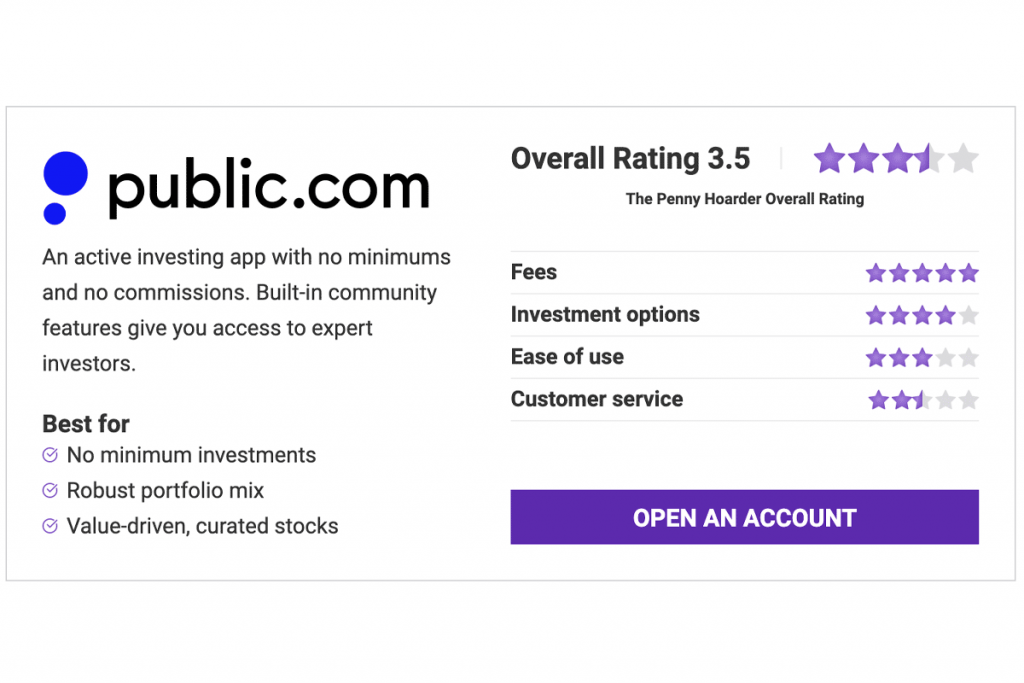by Dana Sitar, CEPF®
Contributor
It’s clear from the popularity of online forums about investing (hi, Reddit), that a lot of beginner investors value the advice of fellow investors as much as — or more than — that of an actual financial advisor.
So it was only a matter of time before an investment app built the community right into its platform.
Public is one of the earliest active investing apps and the only one that puts people and community at the center of its platform.
Through our Public app review, we’ll show you what this app offers for beginner investors, including investment options, fees and requirements (hint: very little), financial education and more.
Public is a popular active investing app that boasts a people-first focus and commission-free stock market trading.
Through the app, you can buy and sell fractional shares of stocks, exchange-traded funds (ETFs) and cryptocurrencies. Most users use the app for long-term investing, but you can use it to build a portfolio as an active trader, too.
Public was one of the earliest apps to make fractional shares easy to trade online, opening up investment opportunities to tons of everyday investors who could never afford to keep up with the likes of Wall Street.
The Public investing app is designed to make buying and selling stocks accessible, improve your financial knowledge, and connect investors to share, learn and build a community.
Public Review: Features and Services
Public is designed for active investing. It offers guidance through educational resources and community to help you curate the portfolio of your choice for short- and long-term investing.
To open a Public account, you have to be at least 18 years old and a U.S. citizen, permanent resident or visa holder with a valid Social Security number and U.S. address.
To get started, you can download the app for iOS or Android and create your account. Don’t forget to include a profile picture to connect with the community!
There’s no minimum deposit required to open your account — but you can’t invest until you move money in to invest with.
You can fund your account by connecting your bank account via Plaid (sign in with your online banking username and password) or confirming your account through microdeposits. You can also fund your Public account with a debit card. You can only withdraw funds to your bank account or via wire transfer, the latter of which comes with a fee of $30.
Before you start investing, the Public team recommends you browse its Investing Themes to discover what kinds of stocks and funds you want to own. You can invest as little as $1 at a time.
The Public app is free to use — you won’t pay a subscription fee or account management fees to have an account on the app. You’ll also pay no commissions, and no fees for basic actions like depositing and withdrawing money or transferring your portfolio balance from another broker.
You’ll just pay fees for less common actions like domestic wire transfers, bad checks and paper statements.
In lieu of trading fees, Public includes an option to tip with your trades. You still get totally commission-free stock trading, but the company hopes users will support the platform through fair tips for the service, as this is one of few ways it earns money.
You’ll pay a trading fee if you invest in crypto through Public, which is split between the company and its crypto broker. The fee is a 1% to 2% markup, so it’s reflected in the price of the currency you buy, rather than added separately as a fee.
Through Public, you can buy and sell stocks available on U.S.-based stock exchanges, via fractional shares and ETFs. It offers more than 5,000 stocks and funds, covering the majority of publicly traded companies in the U.S.
Unlike many micro-investing apps, Public does not offer curated or managed portfolios. You have to choose each stock, fund or currency you want in your portfolio. It also doesn’t support mutual funds.
It does, however, suggest “investing themes,” curated lists of stocks and funds that align with a set of interests of values, like:
Because you actively manage your Public portfolio yourself, you’re responsible for tax management of your investments. Public doesn’t offer tax loss harvesting.
Public doesn’t give you access to professional financial advisors for personal financial advice. Instead, its unique attraction is its strong community of investors and the social media–style feed of stock tips and other investors’ activity.
Through the app, you can peep other investors’ portfolios and follow them to keep up with their moves in the market.
The app also has built-in learning tools, articles and educational events to help you understand the stock market and become a better investor.
Public’s one-on-one customer support is sparse. You can contact customer service through live chat once you’re signed into your account in the app or via email at [email protected], but it doesn’t list a phone number.
Instead of robust live support, it publishes an extensive self-service collection of Help articles to answer your questions about the app. And you always have the community to lean on for investment questions.
The Public app has more than 1 million users, according to NextAdvisor, and it enjoys a rating of 4.7 out of 5 stars in the Apple App Store (iOS) and 4.5 out of 5 stars on Google Play (Android).
Public is a popular investing app, but it has benefits and drawbacks like any other.
Public might be right for you if….
Public might not be right for you if…
We’ve rounded up answers to the most common questions about Public investing app.
Dana Sitar is a Certified Educator in Personal Finance®. She’s written about work and money for publications including Forbes, The New York Times, CNBC, The Motley Fool, The Penny Hoarder and a column for Inc. Magazine. She founded Healthy Rich to publish stories that illuminate the diversity of our relationships with work and money.
Ready to stop worrying about money?
Get the Penny Hoarder Daily
Privacy Policy
© 2021 The Penny Hoarder. – All rights reserved.
Privacy Policy and Terms of Service | Do Not Sell My Personal Information | Cookies Settings






